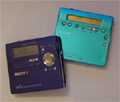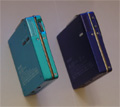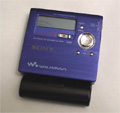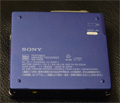I. Introduction:
NET MD, where art thou...
After Sony announced the NET MD protocol back in June, many MD fanatics were fully expecting Sony to implement this in the new line of MD units for 2001-2002. Unfortunately Sony disappointed many when they released the specs for this year's new portable MD model, the R909. While the lack of NET MD is certainly a letdown, it should not be completely lost that Sony has produced a very good unit in the R909. The incredible MZ-R900 is a tough act to follow, but Sony seems to have added a few key features that R900 owners will certainly appreciate.
Net MD Update (9/13): Sony has already come out and announced the first NetMD products, notably the MZ-N1, which is very similar to the R909, but with NetMD capabilities, scheduled for release in Japan on Dec 10. Here are a couple of links, but they are both in Japanese:
[ Sony's NetMD Info Page • Sony MZ-N1 Info Page ]
[to translate the pages to English, try using Babel Fish]

I will say that although the R909 is a significant improvement over the R900 (adjustable recording levels during recording and separate L and R level meters), there were a couple of small steps taken backwards. That is, while last year's R900 was an improvement in just about every single aspect over its predecessor the R90/91, the same cannot be said about the R909. While not too major, Sony did make a few compromises that might be a disappointment to fans of the R900. But perhaps this was the necessary tradeoff of making improvements... For instance, compared to last year's R900, the new R909 is a bit slower in start-up and tracking, and the color of the text on the display is blue, not black - making it a little more difficult on the eyes. However the motor noises on the R909 are significantly quieter, and the Sony engineers managed to squeeze out a few more hours of battery life. So the sacrifices are not completely without reward.
![Sony MZ-R909 and included contents [photo courtesy of Japan-Direct.com]](R909photos/jd_contents_120.jpg)
If you already own an R900, here are some of the things that are new in the R909:
- Adjustable Recording Levels DURING RECORDING - Yes, this is real (credit goes to Ant Wiles for discovering this). You still need to go into the menu while paused and change the RECVOLUME setting to MANUALREC, but once you do this, you can use either the |<< and >>| buttons or the jog dial to adjust the levels while recording. Once you push STOP however, the RECVOLUME will still revert to AUTO REC.
- Group Function - With the advent of MDLP, keeping track of up to 320 minutes of music (and navigating through on big pool of 40-50 tracks) became a potential chore. The GROUP function allows users to organize groups of songs into separate partitions, or "groups" (i.e., by artist/album/genre/etc.)
- ATRAC DSP Type-R - Sony finally puts their high-end ATRAC encoder into a portable. Type-R improves encoding performance in the higher frequencies, but unless you've got golden ears, don't expect to hear much of a difference from ATRAC 4.0 [FYI, MDLP modes do NOT use the Type-R codec, only SP recordings].
- Slightly Quieter Motor - Following Sharp's lead, Sony has cut down on motor noise just a bit. Although the R909 still makes occasional "whirring" noises, it is not as loud as on the R900/R90 generation models. However the R909 is still not as quiet as the Sharp MT77 (and probably the new MT770), and if you plan on using a mic attached directly to the unit without any cable to distance the mic from the MD unit, it might still pick up some soft noises.
- 3 line text display on the main unit's LCD - FINALLY we can see the track number, title, and time simultaneously! The 3 line display gives birth to one of the biggest improvements....

- Separate L and R level meters (!!!) - During recording, the 3rd line of the text display acts as the level meter (a smaller, separate meter at the very bottom of the display is used during playback). This is first Sony MD portable that I have seen with separate level meters for the left and right channels (I don't know about the pre-R3 units). Very significant addition - kudos to Sony on this one. I'm surprised that the press release made no mention of this.
- Fully turning jog-dial - for the first time since the legendary MZ-R50, Sony gives us back a true jog-dial.
- Charging Cradle - Sit the unit in the cradle and let it charge. A convenient accessory that Sony seems to have picked up from Sharp. Charging the battery with the cradle takes longer (~6 hours), and the user has the option of charging the unit the old-fashioned way - plug in the adapter to the main unit and push STOP/CHARGE.
- G-Protection - Sony's newest anti-shock mechanism. Seen earlier on the non-Japanese models of the R900/R700/G750 [and earlier on Sony CD Walkmans], G-Protection eliminates practically all skipping by minimizing the read recovery time, and without relying solely on a buffer. Finally users can go jogging with their MD for more than 40 seconds! ^_^
- LP Stamp - Sony has added the option to turn off the LP stamp. When this option is on (as is by default), an "LP:" will automatically be prepended to the title of any track recorded in an LP mode (but this "LP:" will only show up if you try to play the LP track on an older, pre-MDLP unit). This option was available on most Sony MDLP home decks, but it was missing from the R900. If you're heavy with your track titles, turning this option OFF will help you make the most of the 1700~ character-per-disc limit.
- Sound Presets can now be changed from the main unit. No longer do you need to use the remote to change the bass and treble settings. However, SPEED (pitch) settings still cannot be controlled without the remote.
- Line Out Mode is now completely sticky - meaning, once you set the AUDIO OUT setting to LINE OUT, it will stay there until you manually change it back to HEADPHONE. Previous models (the R900 and R90/91) would automatically revert back to HEADPHONE if you let the unit power off, which was an extremely big annoyance to folks that used their R900 primarily with a bookshelf system, since they would have to go back into the options menu and change the setting back to LINE OUT everytime they turned the unit back on.
- END SEARCH is still there, and like the R900, the R909 will let you automate it by setting the "Rec-Posi" option to "FROM END". And while "FROM HERE" is still the default setting, Sony appears to be learning: If you have GROUP mode turned ON, recording will start from the end of the current group, even if the "Rec-Posi" option is set to "FROM HERE"! Pushing END SEARCH in GROUP mode will tell the R909 to start a new group. So if you have GROUP mode ON, you will never have to worry about accidentally overwriting existing material. Perhaps this is the closest we will get to completely eliminating END SEARCH as we know it (?).
- Group Function - With the advent of MDLP, keeping track of up to 320 minutes of music (and navigating through on big pool of 40-50 tracks) became a potential chore. The GROUP function allows users to organize groups of songs into separate partitions, or "groups" (i.e., by artist/album/genre/etc.)

 Import Warning
Import Warning
If you live outside of Japan and are afraid to import this beautiful unit, I really don't know when the R909 will be available in other territories. The UK release is rumoured to be in January 2002; as for the U.S. release, I won't even bother guessing (since the R900 took eight long months to make it stateside). If you ask Sony about the R909's release date in your country, they'll probably tell you that they "don't know anything about the R909" (typical corporate response), so don't expect too much help from your local Sony branch. The R909's instruction manual contains a complete English section, and all of the body labelings and menu options are in English, so the R909 is fully usable if you don't know any Japanese. So if you decide to take the plunge and import this fine machine (as many of you will), there are three things to be aware of when importing a Japanese product: Import taxes, Voltage, and Warranty. • Import taxes are more of a concern in Europe, where no matter who you import from, you're likely to get slapped with a fairly significant duty bill - do some research to find out exactly what percentage (most internet retailers are selling the R909 for somewhere in the $300 - $350 range, US Dollars). If you live in the states, imported electronics are subject to customs charges, however, I have not once heard of anyone in the US being charged import taxes on an MD unit. But that doesn't mean that it can't happen, so don't cry foul if you're the first. • Voltage differences are a source of much confusion for those that have never before imported electronics from another country. The Japanese model of the R909 comes with a 100V AC adapter, and unless you live in Japan, the AC voltage in your country will be something other than 100 (it is 110-120VAC in North America, and ~220VAC in Europe, OZ, and other parts of Asia). To put it simply, if you use the included 100V adapter in your country, the adapter will supply the wrong voltage to your MD unit. If you live in the US, you might be able to get away with using the Japanese adapter, since the voltage difference is only about 15% (and this is what a lot of users in the US do). However, there is a slight risk of damage (and if you use the 100V adapter in the US to charge the battery, over time your rechargeable battery will wear down prematurely), so if you live in North America, it is strongly recommended that you get a proper 120V AC adapter (output specs are 3V DC, with at least 500mA - Sony adapter model# AC-E30HG meets these specs and are available at most Best Buy locations).
• Warranty is something that some users ignore - and end up paying the price for. Like most portable electronics in Japan, the R909 comes with a 1 year Japanese warranty (assuming your unit was obtained from a proper outlet, and not from the "gray" market). However this warranty really is only for people in Japan, so should you ever have a problem with your unit, you would need a contact with an address in Japan that could send your unit to Sony for you. Some retailers will do this for you (Japan-Direct and a few others), while many just stick you there with the unit, even if it goes defective. Be careful when you are shopping around the internet, and make sure that your back is covered if your unit decides to turn into a $300+ paperweight. Note that even if the retailer that you order from does offer warranty support, you will usually still need to send your unit back to them (in Japan, or wherever they are located), and this process usually has a turnaround time of 3 - 5 weeks. Sound like a long time? It sure beats being stuck with a lemon.
|
Things I would LIKE to see on the next model:
In no particular order: NET MD (obviously); a backlight on the main unit's LCD; the ability to turn off automatic track-marking; even quieter motor noise (something on par with the Sharp MT77); and quicker motor response times. Otherwise, with the improvements that Sony has implemented in the R909, this is probably Sony's best unit yet.
![Nice side-by-side shot of the Sharp MT770 (silver) and Sony MZ-R909 (red) [photo courtesy of mdman.net]](R909photos/mk_770_r909_angle_120.jpg)
![Nice angled shot of the R909 (red) and MT770 (silver) [photo courtesy of mdman.net]](R909photos/mk_r909_770_side_120.jpg)
![Shot of the MT770 (silver) and R909 (red), showing the relative thickness of each unit (yes, the Sharp is a little thinner) [photo courtesy of mdman.net]](R909photos/mk_770_r909_thin_120.jpg)
Side-by-side shots of the Sharp MT770 (a.k.a. MT888) and the Sony R909
[photos courtesy of mdman.net]
Overall, I think the R909 is a very nice unit. If you don't currently own an MD unit and are looking to buy one, this unit is a winner. But if you already own a unit (especially the R900) that you are happy with, the improvements made to the R909 are marginal, and don't really scream for an upgrade. Also, the R909 may end up being one of those "in-between" generation units, since NETMD seems to be just around the corner - Sharp is already showing off their prototype NETMD unit (dubbed the MT899) in Germany, which reportedly features LP4 transfers via USB at 16x speed... my guess is LP2 would occur at 8x, and SP at 4x, but that's just my speculation. So while some users may wait for the NETMD generation, the R909 is here - now. Read on for all the details on Sony's latest MD wonder...
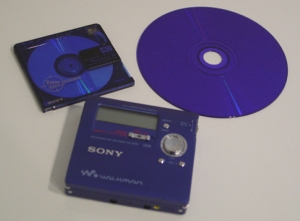
 Images:
Images:

